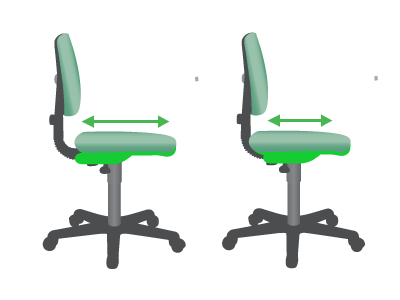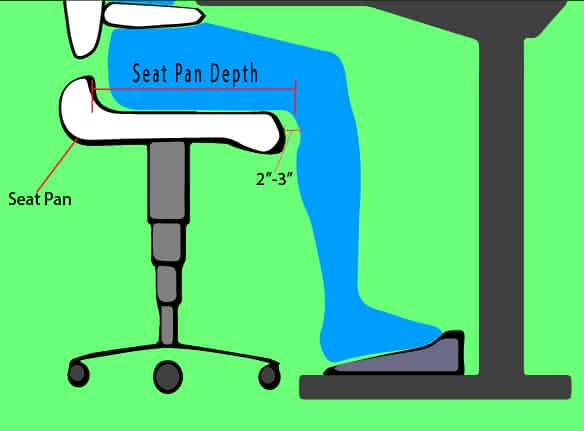Seat pan size and depth adjustment is a key aspect of workplace ergonomics that often goes unnoticed. It plays a significant role in ensuring comfort and enhancing productivity during long hours of work. This guide aims to shed light on the importance of seat pan size and depth adjustment, how to achieve the ideal chair depth, and the latest trends and statistics in the field.
Understanding Seat Pan Size and Depth
What is Seat Pan Size and Depth?
The seat pan is the flat surface you sit on. Its size and depth are critical factors in determining the comfort and ergonomics of a chair.

Why is Seat Pan Size and Depth Important?
The importance of seat pan size and depth lies in its impact on the user’s posture and overall health. An incorrect seat pan size or depth can lead to discomfort and health issues such as back pain, neck strain, and carpal tunnel syndrome.
How to Determine the Right Seat Pan Size and Depth

Achieving the ideal seat pan size and depth is not a guessing game. Here’s a step-by-step guide:
- Measure your hip breadth: The width of the seat pan should be at least an inch wider than your hips on both sides.
- Measure your thigh length: Sit on the edge of a flat surface and measure the length from the back of your buttock to the back of your knee. This will give you an idea of the ideal depth of the seat pan.
- Adjust the chair depth: If your chair has a seat slider, adjust the depth until there is about an inch of space between the back of your knees and the edge of the seat pan.
Factors to Consider When Adjusting Seat Pan Size and Depth
When adjusting your seat pan size and depth, consider the following factors:
- User’s body dimensions: Individuals with wider hips or longer thighs will require a larger seat pan.
- Type of work: The nature of the work can also influence the ideal seat pan size and depth. For instance, tasks that require leaning forward may require a shallower seat pan.
Challenges and Solutions in Seat Pan Size and Depth Adjustment
Adjusting seat pan size and depth is not without its challenges. Here are some common issues and their solutions:
- Seat pan is too small: If the seat pan is too small, it may not provide adequate support, leading to discomfort and health issues. Consider getting a chair with a larger seat pan.
- Seat pan is too deep: If the seat pan is too deep, it can put pressure on the back of your knees, affecting blood circulation. Consider getting a chair with a shallower seat pan or a seat slider for adjustable depth.
The Role of Ergonomic Chairs in Seat Pan Size and Depth Adjustment
Ergonomic chairs come with a range of features that aid in seat pan size and depth adjustment. These features include:
- Seat slider: This feature allows for easy adjustment of the seat depth.
- Adjustable seat pan: Some chairs come with seat pans that can be adjusted in size to fit the user.
Latest Trends and Statistics
Here are some of the latest trends and statistics in seat pan size and depth adjustment and office ergonomics:
- The use of ergonomic chairs with adjustable seat pan size and depth is increasingly being recognized as a crucial factor in modern offices.
- Every year, a significant number of seats are equipped with various adjustment points within the seat pan size and depth, reflecting the growing awareness of the importance of ergonomics.
- The typical computer chair seat pan size range is 17″ to 20″ in width and 15″ to 18″ in depth. However, research suggests that adjustability is key, and the dimensions should match the anthropometrics of the user to prevent abnormal strain of the neuromuscular system.
- Adjustable ergonomic office chairs typically range from 17″ to 21″ in width and 16″ to 21″ in depth. These chairs are designed to prevent musculoskeletal discomfort and pain, particularly among workers who are required to sit for prolonged periods.
- Office chairs for short people can go as low as 14.5” in depth, while ergonomic office chairs for tall people can be adjusted beyond 21” in depth. The adjustability of these chairs is crucial in preventing musculoskeletal symptoms.
- Studies have found a consistent trend that supports the role of a chair intervention in reducing musculoskeletal symptoms among workers who are required to sit for prolonged periods. However, more research is needed to confirm these findings and to determine the long-term benefits of such interventions.
Please note that this information is based on the latest research and trends in the field of office ergonomics and seat pan size and depth adjustment. It’s always a good idea to consult with a professional for personalized advice.
Read More >> Ergonomic Chair Buying Guide: Essential Tips for Beginners
Conclusion
Understanding the importance of seat pan size and depth adjustment and how to achieve the ideal chair depth is crucial for anyone who spends significant time at a desk. It not only ensures comfort but also enhances productivity by reducing the risk of discomfort and health issues. Remember, the best chair for you is the one that fits your body, meets your needs, and feels comfortable. So, take the time to adjust your seat pan size and depth and enjoy the benefits of improved comfort and productivity at work.



